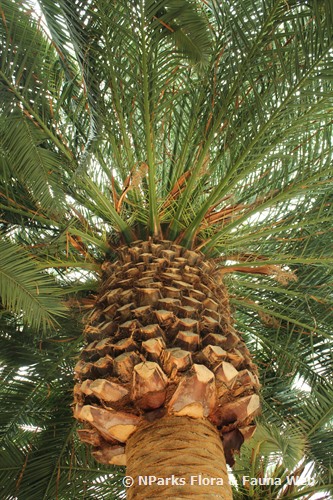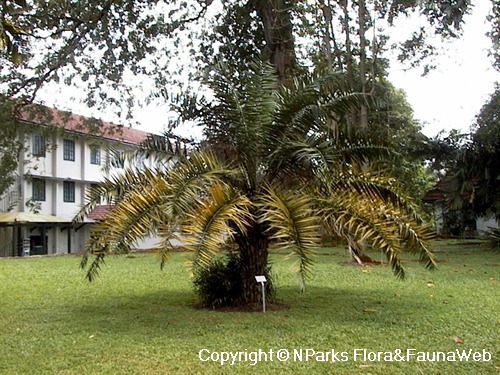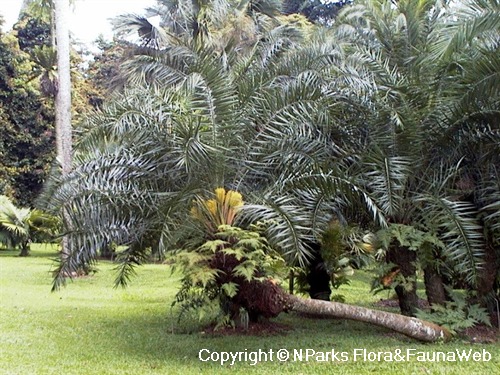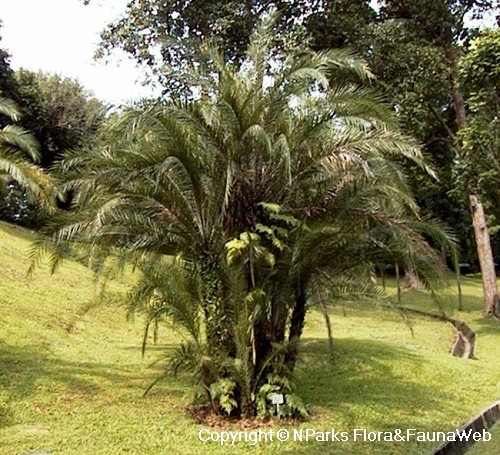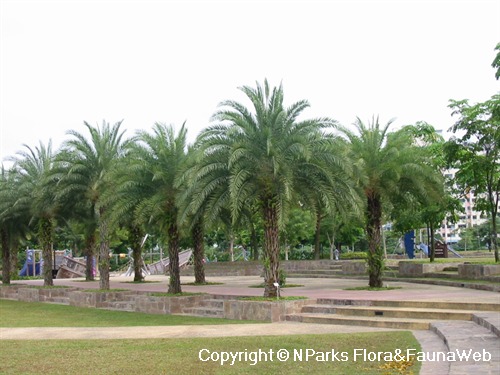
Name
Classifications and Characteristics
| Plant Division | Angiosperms (Flowering Seed Plants) |
|---|---|
| Plant Growth Form | Palm (Solitary Habit) |
| Maximum Height | 21 m |
Biogeography
| Native Distribution | Endemic to Canary Islands. |
|---|---|
| Native Habitat | Terrestrial |
Description and Ethnobotany
| Growth Form | It is a solitary palm, up to 21m tall, and has diamond-shaped leaf base scars below leaf crown. |
|---|---|
| Foliage | Leaves are large (2 – 6 m long), arching, blue-green, pinnate. Leaf comprises of about 200 stiff leaflets on each side (20 – 30 cm long), arranged in a V shape. Leaf sheath reddish brown and fibrous. Leaflets near the base are modified into spine (up to 20 cm long) which points in several direction, green when young and turning yellow as it mature. |
| Flowers | The bract enveloping the male inflorescence is about 40 cm long, with brownish hairs and split two times between margins when mature. The male inflorescence is erect (about 50 – 70 cm long), and comprises of yellow-white male flowers crowded along full length of stalk. Female inflorescence bearing bract is about 60 cm long and split one time between margins when mature. Female inflorescence is erect at first and becoming pendulous (1.6 – 2 m long) and comprises of yellow-white female flowers which are distally arranged on the stalk and slighting scented. |
| Fruit | Fruit is obovoid (1.5 – 2 cm long and 1.2 cm wide), yellow-green when young and turning yellow-orange when ripe. Seed is ovoid, about 15 mm long and 10 mm wide. |
| Habitat | It occurs in open areas of moist forest as well as semi-arid areas where there is abundant groundwater, up to 600 m altitude. |
| Cultivation | Fresh seeds germinate within 30 days. P. canariensis is weak against wilt disease caused by Fusarium oxysporum. |
| Etymology | The genus epithet Phoenix derives from the Greek name for the date palm, in reference to the fruit the genus produce. Species epithet means of the Canaries in latin, and genys is greek for date palms. |
| Ethnobotanical Uses | Others: Leaves are used for weaving baskets and stem provides sugary sap which is eaten as palm sugar. In Malta, fishermen use the large palm leaves to attract fishes into their nets. |
Plant Care and Propagation
| Light Preference | Full Sun |
|---|---|
| Water Preference | Moderate Water |
| Plant Growth Rate | Moderate |
| Rootzone Tolerance | Well-Drained Soils |
Foliar
| Mature Foliage Colour(s) | Green |
|---|---|
| Leaf Area Index (LAI) for Green Plot Ratio | 2.5 (Palm - Solitary) |
Non - Foliar and Storage
| Trunk Type (Palm) | Solitary Habit, Aboveground |
|---|
Floral (Angiosperm)
| Flower Colour(s) | Cream / Off-White |
|---|
Fruit, Seed and Spore
| Mature Fruit Colour(s) | Yellow / Golden, Orange |
|---|
Image Repository
Others
| Master ID | 1369 |
|---|---|
| Species ID | 2662 |
| Flora Disclaimer | The information in this website has been compiled from reliable sources, such as reference works on medicinal plants. It is not a substitute for medical advice or treatment and NParks does not purport to provide any medical advice. Readers should always consult his/her physician before using or consuming a plant for medicinal purposes. |

